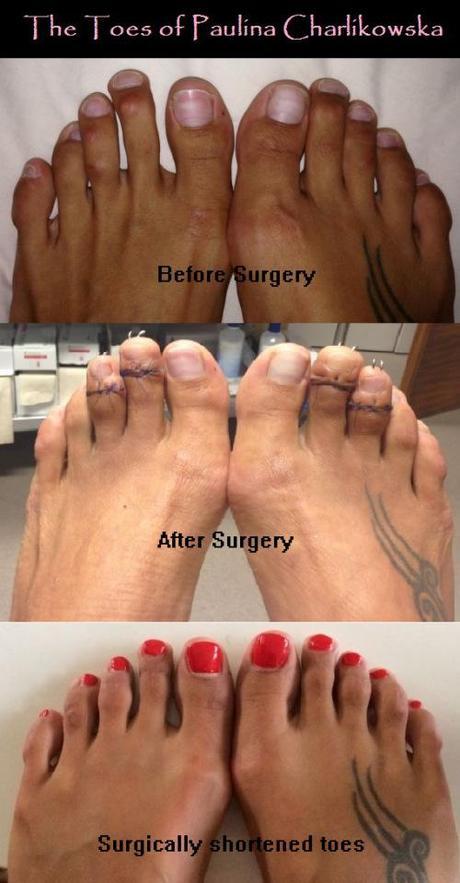It is not news that many women torture themselves by wearing uncomfortable shoes, especially high heels, in their quest to be fashionable and sexy. (See “What high heels do to women’s feet.”) The Daily Mail has a statistic that, for reasons unknown, an incredible 71% of women knowingly buy shoes that are too small for them.
That being said, some women have taken their obsession with feet and shoes to a whole new level.
While millions of people around the world, especially those in Africa and India, are desperately poor, living at the edge of starvation, there are women in the affluent West who actually spend thousands of dollars for medically unnecessary surgery to shorten their toes so that they look better in so-called “sexy” open-toe high heels.
In recent years, “Cinderella surgery” to alter the shape and size of a woman’s feet for reasons of vanity has become popular in America and Britain. Increasing numbers of clinics are capitalizing on some women’s yearning for perfect-looking feet by offering surgical procedures that include shortening or lengthening toes, shaving off excess bone to remove “unsightly” lumps and bumps, and even sucking excess fat from big toes.
Dr. Jason Hargrave, consultant in podiatric surgery at the UK’s Cosmetic Foot Surgery Centre, says: “Cosmetic foot surgery is a rapidly growing trend, fueled by the popularity of Sex-And-The-City-style killer heels. They’re seen as the most glamorous, desirable accessory, and not being able to wear them can be depressing. All my patients say they long to wear open-toed shoes, but that they can’t because they hate their feet. In many cases, they go to extraordinary lengths to hide them, even from their own husbands. Now there are procedures available in the UK to change them, many women are jumping at the chance.”

Paulina Charlikowska
30-year-old Paulina Charlikowska, a beauty salon owner from Blackpool, England, is one of those women. She tells Daily Mail:
“It sounds silly, but I’ve always hated my feet and felt too embarrassed to get them out in front of my friends. Even as a child, I thought they didn’t look normal. I was revolted by them. It didn’t help that my feet were a huge size eight, which meant shoes looked ungainly, and my second and third toes were longer than my big toes. I would squeeze my feet into shoes two sizes smaller, so my toes were always sore and covered in corns. I knew I was making my feet look even worse, but I couldn’t bear to wear big, ugly shoes. Because I work in the beauty industry, I spend all day looking at people’s feet, which made me even more unhappy with my own.”
Then Paulina saw a television documentary about a woman having her toes surgically shortened. She says, “From that moment, I became obsessed with finding a way to have the operation. My husband Jacob, who’s a manager at an air-conditioning company, thought I was mad. He doesn’t believe in surgery unless it’s necessary, but when I started saving the £4,500 I needed, he realized he couldn’t stop me.”
[Note: At today's exchange rate, £4,500 = US$7,661.]
In October 2013, Paulina had her second and third toes shortened by a centimeter by Dr Hargrave, in an operation that took place under local anaesthetic.
“It took an hour and although I couldn’t feel anything, I could hear my bones being sawed and crunched, which was horrible,” she says. “There was no pain afterwards, but I had wires in my toes for five weeks and one toe became infected, so I had to take antibiotics. After the wires were removed I walked using crutches for a couple of weeks before I could walk normally again, although I couldn’t exercise for six months. Now I’m fully healed I have small scars, but they’re barely noticeable, and my feet are a size smaller now, too. My husband and friends still think I’m crazy to have spent £4,500 on my toes, but I believe that if you hate a part of your body and it’s affecting how you feel, there’s nothing wrong with getting it fixed. I’m so proud of my new feet.”

However, many doctors have reservations about “Cinderella surgery.” Orthopedic surgeons have warned that many foot surgeries are highly invasive as they involve cutting toes open, sawing the bones in two and screwing them back together, so the potential is high for serious complications, including permanent pain and restricted joint movement.
Dr. Andrea Sott, a consultant orthopedic foot and ankle surgeon at St Anthony’s Hospital in Surrey, says: “Surgeons registered with the British Orthopedic Foot and Ankle Society, the regulatory body, would only perform foot surgery to relieve pain or correct a deformity such as severe bunions or clawed toes. We do not endorse this type of surgery for purely cosmetic reasons, because of the risks it carries, including swelling, stiffness and not healing properly. It’s not uncommon for some procedures to create pain and restricted joint movement where there was previously no problem — for example, to go from having pain-free but unsightly toes to good-looking but painful, swollen toes. In the most extreme cases, there’s even a small risk of life-threatening blood clots. Even when surgery is successful, it involves spending at least six to eight weeks recovering. I would never recommend it unless it’s necessary.”
Many experts are concerned that a growing number of surgical procedures are being carried out by podiatrists, who are not orthopedic surgeons but instead treat in-growing toenails, corns, calluses and verrucas. While a consultant orthopedic surgeon would have extensive training of around 16 years, podiatrists can perform surgery under local anesthetic after a one-year postgraduate course, and are not required to state whether they have any additional surgical qualifications. So there is no way for the public to check a practitioner’s suitability.
Danielle, 37, a full-time mother to her 9-month-old boy, discovered the pitfalls of Cinderella surgery when she had her hammer toes corrected by a surgeon at a private London hospital two years ago. Hammer toes occur when the smaller toes are pushed — usually by too-narrow shoes — into a bent position at the middle joint. Eventually, the muscles in the second, third and fourth toes become unable to straighten, leaving them with a claw-like appearance.
Danielle had surgery under general anesthetic, in which hooks were inserted into her toes to straighten them. She also had her bunions removed at the same time, which involved cutting open her feet, correcting the alignment of her big toes and sawing off excess bone. The procedure was paid for by private medical insurance.
“After the operation, I was in excruciating pain, and it soon became clear that something had gone wrong, because my toes were sticking up at a weird angle,” she says. “They didn’t touch the floor when I stood up. A few weeks later, I had to have a second operation to try to correct them, but they still have an upwards slant. After six weeks, they pulled out the hooks in my toes without anesthetic, which was so painful I almost passed out. I had to take six months off from my job as a PA, because I couldn’t walk and my feet were massively swollen. I think now that the surgeon was more concerned with correcting the appearance of my feet than their function. He didn’t explain to me the impact the operation would have on my body as a whole.”
Danielle can no longer wear high heels: “I can’t bend my feet enough to put them on, let alone walk in them. I’m resigned to the fact that most fashionable, sexy shoes are out of the question, and I’ll spend my life in flats. People should think very carefully before they jump into having foot surgery for cosmetic reasons. It’s not worth the risk just for the sake of vanity — my feet are more painful now than they were before.”
~Eowyn

